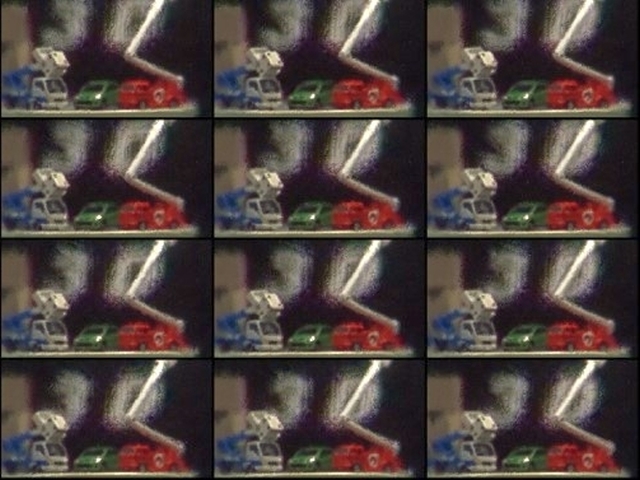Integral photography
Holography is not suitable for recording real scenes under natural light. This is a problem for realizing 3D television. To solve this issue, a real-scene CGH reconstruction system using integral photography (IP) has been developed [1]. IP is a 3D photographic technique to obtain 3D information under natural light by recording intensity and direction of light. In our laboratory, we have studied improving the reconstructed image quality, expanding viewing angles of the reconstructed image, and fast CGH calculation for real-time processing.
Improving the reconstructed image quality
IP camera records objects from many angles using a lens array, which consists of many convex lenses. Therefore, by rearranging pixels in the recorded image, we can obtain many images from different viewpoint as shown in right images. Applying reconstruction-based super-resolution to the rearranged images enables us to generate high-resolution CGH. As a result, we realize improving the reconstructed image quality.

Expanding viewing angles of the reconstructed image
In the conventional method, the viewing angles of the reconstruction image of this system, i.e. range where we can observe the reconstructed image, was only 5 degrees in both horizontal and vertical directions. To expand the viewing angles, we proposed a novel method. In this method, we reconstruct three images having desired directional information from an image captured with the IP camera. Then, we generate three CGHs from the reconstructed images and display CGHs by time division. As a result, we can expand the viewing angle in horizontal direction to 15 degrees. The reconstruction images by the proposed method is shown in right movie.
Fast CGH calculation using GPU
The image recorded by IP consists of many small images called as elemental images. CGH calculation can be computed for each elemental image independently. We performed the CGH calculation for each image in parallel by using GPU and achieved the 22 times faster CGH calculation than conventional method.

References
- R. Oi, et al., gFFT-Applied Hologram-Generation using Integral Photographyh, IEICE Tech. Rep.105, (2005)
- Yoji Shibuya, Tomoki Hayashi, Tomohiro Suzuki, Yasuyuki Ichihashi, Ryutaro Oi, Kenji Yamamoto, Takashi Kakue, Tomoyoshi Shimobaba, and Tomoyoshi Ito, "Integral Photographic Camera with Different Angles of View in Horizontal and Vertical Directions for Quality Improvement of Holographic Images," 3D systems and Applications (3DSA2015), 3DSA S2-3, Taipei, Taiwan, Aug. 2015.
- Tomohiro Suzuki, Tomoki Hayashi, Naoki Hirata, Yasuyuki Ichihashi, Kenji Yamamoto, Takashi Kakue, Tomoyoshi Shimobaba, and Tomoyoshi Ito, "Implementation of Hologram Generation from Integral Photographic Image with Wide Viewing-Zone Angle on GPU," 21st International Display Workshops (IDW'14), 3Dp1-16, Niigata, Japan, Dec. 2014.
- Tomohiro Suzuki, Tomoki Hayashi, Naoki Hirata, Yasuyuki Ichihashi, Kenji Yamamoto, Takashi Kakue, Tomoyoshi Shimobaba, and Tomoyoshi Ito, "Speeding Up of Hologram Generation for Integral Photographic Image of Wide Viewing-Zone Angle," International Symposium on Three Dimensional systems and Applications (3DSA) 2014, 2014-071, Seoul, South Korea, May 2014.
- Tomoki Hayashi, Naoki Hirata, Yasuyuki Ichihashi, Kenji Yamamoto, Takashi Kakue, Tomoyoshi Shimobaba, Tomoyoshi Ito, "Enlargement of Viewing Zone of a Holographic Image Generated from an Image Captured by Integral Photography," 20th International Display Workshops in conjunction with Asia Display 2013 (IDW/AD'13), 3D3-3, Sapporo, Japan, Dec. 2013.
- Naoki Hirata, Yasuyuki Ichihashi, Kenji Yamamoto, Tomoki Hayashi, Takashi Kakue, Tomoyoshi Shimobaba, and Tomoyoshi Ito, "Improvement of holographic image considered on chromatic aberration of captured image by integral photography," International Symposium on Three Dimensional systems and Applications (3DSA) 2013, S8-2, Osaka, Japan, June 2013.